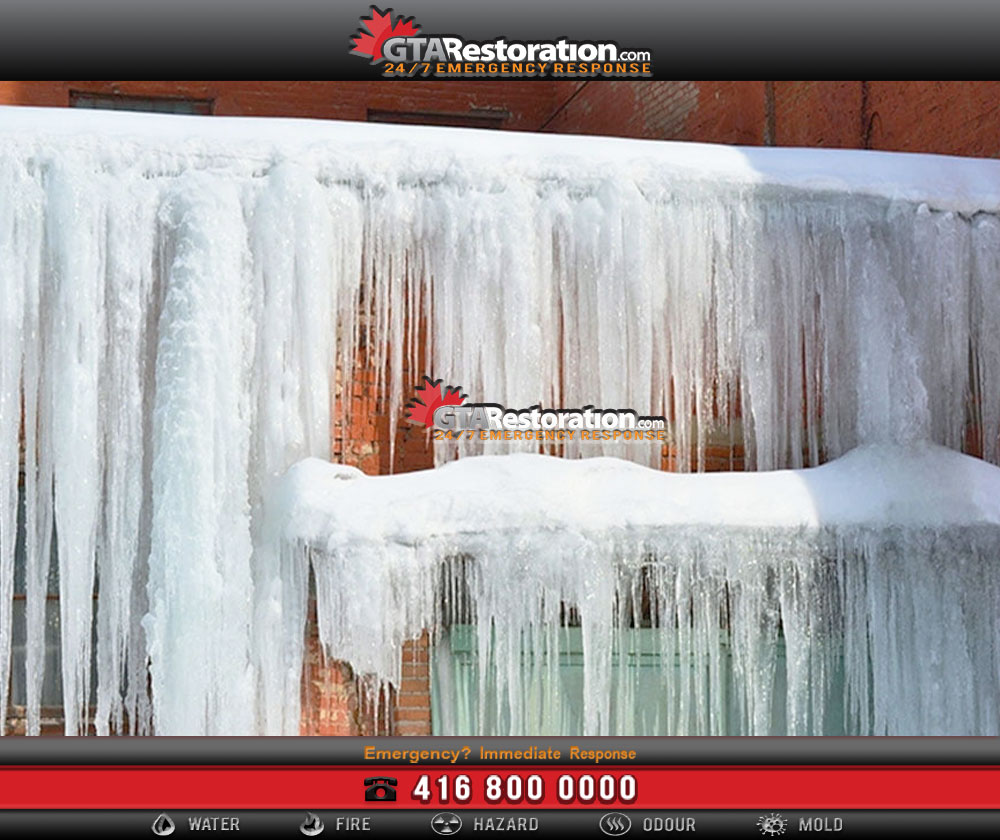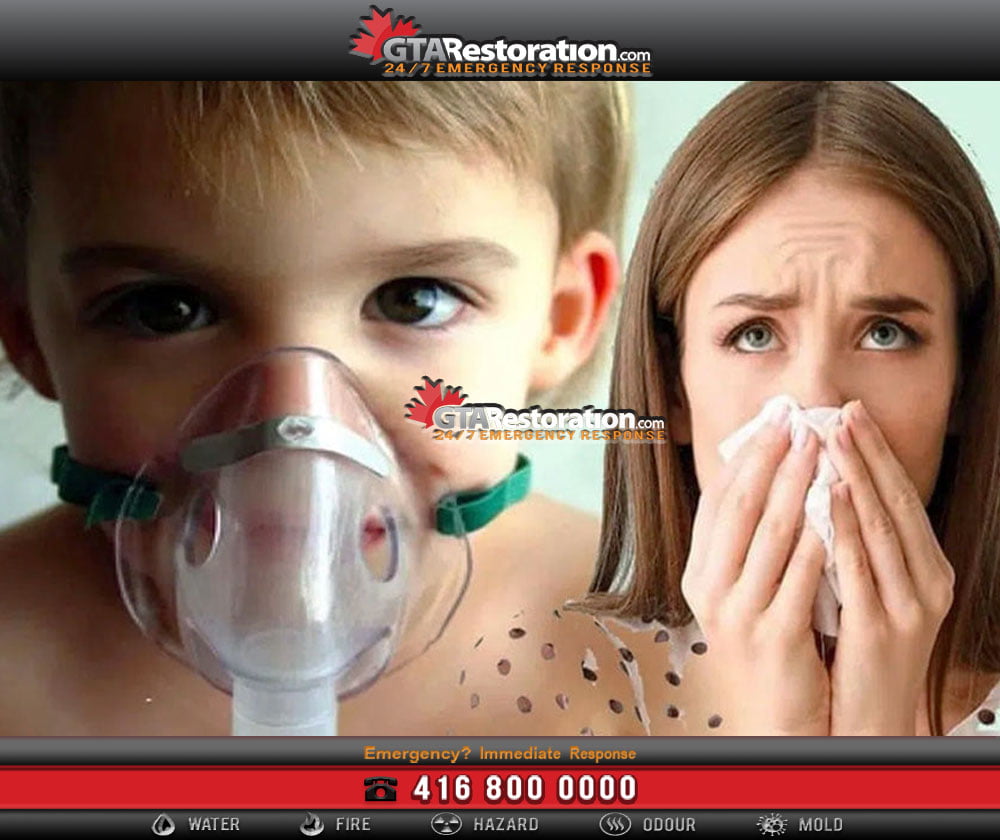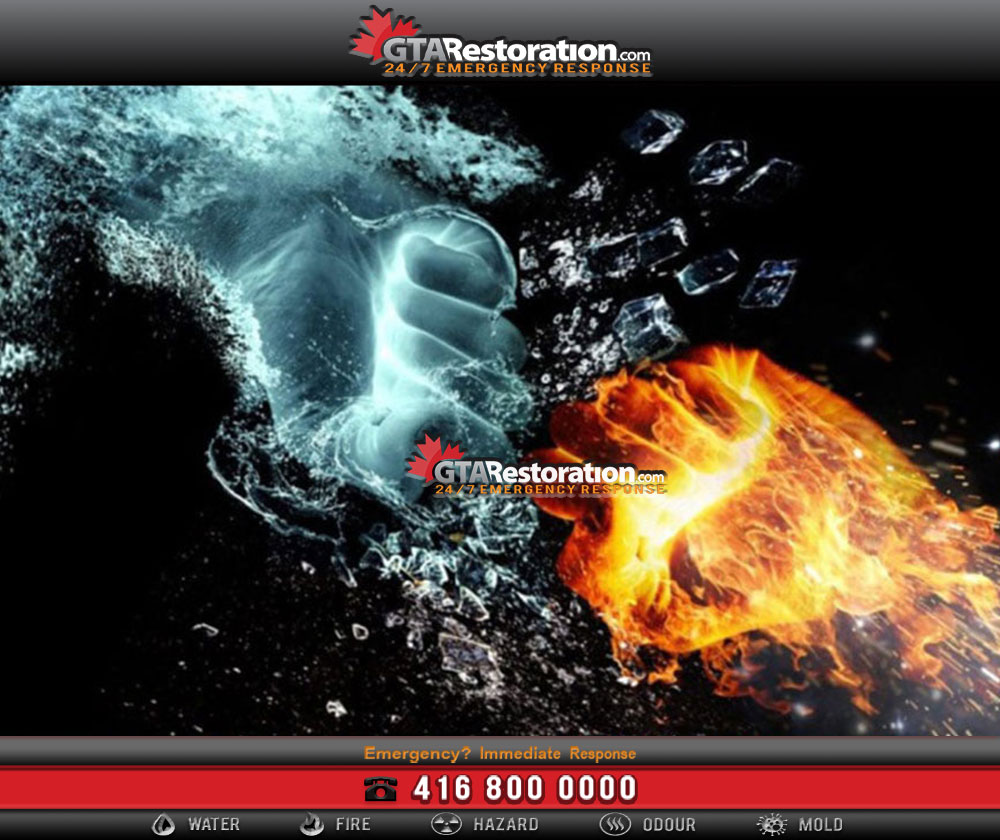Every year, when the weather starts to cool down and winter approaches, we get excited about everything that comes with it. We love seeing the leaves change color, spending time outdoors in the fresh air, playing football with friends and family, and of course – snow!
If you live in an area with winter weather, you’ve likely had to deal with snowfall at some point. An ice dam can form regardless of location if you have experienced snow accumulation, freezing temperatures, and certain building conditions.
An “ice dam” is a wall of ice that blocks water from flowing freely off your roof. It can form when heat escapes through the upper part of your walls and melts the snow on your roof. The melted snow flows down to the colder edges of your ceiling, where it refreezes into an ice dam. Heat escaping from the home or building into areas such as attics or rafter cavities melts snow on the roof. The melting snow will reach the eaves and freeze because heat can’t escape from this area. This causes a buildup of ice that blocks the flow of water, called an “ice dam.”
This article will explore the causes of ice dam house damage and strategies to prevent damaging outcomes if an ice dam forms. Additionally, we’ll look at ANSI/IICRC standards to determine the categorization of water from ice dams.
The Basics of Ice Dam:
An ice dam house damage is a wall of ice that blocks water from flowing freely off your roof. There are several important distinctions between an ice dam and typical snow accumulation on the roof that can result in property damage if not addressed promptly. A few key points differentiate an ice dam condition from specific snow accumulation on a roof:1. Outside temperatures must be consistently below freezing for an ice dam to form. An ice dam is unlikely to occur during the early stages of winter when temperatures decrease or fluctuate above and below freezing throughout the day.
2. A large snowpack must rest on the roof for an ice dam to form. If the snowpack is not dense enough when it melts, there might not be sufficient water to create the dam or for the water build-up behind it to seep into the building’s structure. Moisture can only enter through two ways: holes, cracks, etc. The second way water causes deterioration is when it seeps through already-present cracks or flaws. Ice dams generally form in the gaps between roofing materials and penetrate areas where two pieces of oriented strand board (OSB) tongue and groove joint, or by being absorbed into the material. In other words, water can “flow back into the building structure” due to the dam.
3. For an ice dam to form, a heat source must warm up the roof sheathing and melt the snowpack. This heat source can typically come from inside the building but can also be generated by solar radiation that heats snow accumulation. Ice dams can occur on your roof when the cold or freezing wind blows into the attic, cooling the back of the interior OSB.
Why are Ice Dams Problematic?
Dams often damage your property, including ripped-off gutters, loosened shingles, and backed-up water that pours into your house. Water damage manifests as peeling paint, warped floors, and stained and sagging ceilings. In addition, soggy insulation in the attic causes mold and mildew growth.
Rainwater is typically diverted away from a house through gutters and downspouts, but when a dam forms in these channels due to blockage or an overflow of the system, the water can start to build up and cause damage. The water might erode and pull away at the gutter materials, resulting in sections becoming loose or detaching completely.
This same force can affect rooftop shingles, causing them to become weak and lift from the home’s surface.
Unfortunately, this does not stop there; if left unattended, the excess water will eventually flow into your house and create several unpleasant problems. Peeling paint, warped floors, and stained ceilings – all are common side effects – as well as soggy insulation in the attic, which reduces its R-value (the ability to resist heat) and increases its vulnerability to mold growth.
Ventilation
Ice dams are far less common during the early winter, with lower snowfall totals and temperatures remaining within a 20-30°F range. By contrast, later in the season brings weather perfect for creating an icy dam, with temperatures often dipping below freezing. In February 2010, Pittsburgh, Pennsylvania, experienced an extreme snowfall of 24 inches over three days. The temperatures at the time and for two weeks after were below freezing, dropping to the low 20s and teens.
Structures in the Pittsburgh area saw increased ice dam issues due to extreme weather conditions. It’s important to note that weather can vary significantly across different geographic regions, resulting in varying levels of frequency and intensity when it comes to ice dams.
Mitigation
When meltwater from an ice dam leaks through a ceiling into a home, leading to damage, clients regularly ask about steps to prevent damage. The typical problem with snow is that it will become absorbed or collapse a roof with its weight. The solution to this problem is very simple — remove the water source. Although the key itself is effective, removal can be difficult and dangerous.
If we remove the water source — the snow — not only will the ice dam have no opportunity to grow, but water will also be prevented from seeping under the roofing material and into the house. Even though it may seem easy, attempting to remove snow from an icy and steep roof covered in snow is extremely dangerous.
In addition to the dangerous conditions mentioned above, weight from several feet of snow on a roof – combined with workers shoveling while standing on that same roof – could cause it to collapse suddenly.
Only experienced professionals working under these circumstances should be hired to repair damage from an ice dam.
Things to Avoid When Dealing with Snow Accumulation
If the snow cannot be removed, what should be done? Let’s first discuss what not to do.
- Should not remove the gutters: Although getting rid of the gutters may get rid of some ice dams, it usually only eliminates the bottom part of the dam. The top section by the eave will still be there. Moreover, it is unsafe to try and take down a frozen piece of gutter that is several feet up in the air.
- Do not use tools such as an ax or hammer to break the ice dam: Striking ice that is stuck to frozen and brittle shingles or in the gutter increases the chances of damaging existing structure materials. Typical damage sustained includes cuts, punctures, and displacement of the material. As the ice begins to melt, beware of water seeping into your home through any holes that the physical removal of the ice dam may have created.
- Applying salt or calcium chloride to an ice dam is unnecessary and may even cause damage: This might theoretically work, but it’s unlikely to succeed if the snowpack above the ice dam hasn’t melted yet and exterior conditions remain unchanged. Plus, putting these products on roofing materials can cause immediate or long-term damage to the structure.
- Keep the ceiling closed until the water leak has been repaired: Building owners and contractors often decontaminate buildings out of fear al mold growth due to moisture in the ceiling and insulation. This article previously discussed how rising temperatures could warm the roof deck, leading to the formation of ice dams. Opening the ceiling and removing insulation to allow warm air to reach the roof sheeting will not improve the current ice dam situation. However, opening the ceiling once the telltale signs of an impending event are gone for good would be a sound solution.
Water Categorization in ANSI/IICR S500:
According to the ANSI/IICRC S500, Standard and Reference Guide for Professional Water Damage Restoration (S500), water from an ice dam that infiltrates a structure could potentially fall into one of three categories, depending on the specific circumstances.
The water contamination results are as follows:
When water contacts job site materials, its origin, and quality change:
We can always see snow as a form of water that is “clean” because of its source, which is the sky, but other snow, ice buildup, roofing tiles, and a moisture barrier on the roof have contaminated this water as well. For moisture to form between the barrier and the wood knot in the pole or to penetrate through the holes drilled to install the barricade (nails, staples), the ice dam produces moisture between the barrier and the wood knot.
Changes in temperature and the passing of time can amplify contaminants in water, and this can ultimately determine the water’s category:
The concern here is that the described processes could lead to microbial growth and water contamination.
Restorers should be aware that contamination might have occurred. Contamination is defined as the presence of unwanted substances — including location and quantity — which can cause health problems, damage buildings or contents, and negatively affect building systems’ function.
Though some say these categories are for human or animal safety and health, they actually indicate the build’s integrity, materials, assemblies, contents, and products.
According to the criteria laid out in Section 10.4.1 of the S500 document, water is categorized as:
Category 1 Water
As per the S500 document, melting ice and snow are classified as part of Category 1. In the ideal scenario, if the water contains no contaminants or additives that may be picked up during melting or absorption into building materials, it can still be classified as category 1. However, such conditions usually do not manifest in cases of ice damming.
Category 1 events, like a building’s supply line rupture, are made more complicated when regulated materials like asbestos are present and must be removed.
Category 2 Water:
According to the S500 document, category 2 does not address melting ice and snow. It defines it as containing contaminants that could cause negative health effects if touched or ingested by a person. Considering the potential for contamination from passing through building materials, category 2 is likely the most suitable description of water from an ice dam that does not pose any major health risks.
The melting of ice and snow can penetrate the OSB boards, where the glue and wood prevent water from passing through. This would cause it to seep onto insulation material held in place by a felt sheet with alumina backing. Over prolonged exposure to moisture, however, this insulation will lose its ability for absorption and allow the water to drip down towards the drywall ceiling.
A drywall can absorb moisture and act as a barrier, trapping the water inside and preventing it from flowing further. Over time, this accumulating water weight could weaken or damage the drywall ceiling. While the water is not hazardous, the materials it flows through to enter a structure should be avoided. Personal protective equipment should be worn when dealing with any ice dam-related scenarios.
Category 3 Water
Also, according to the S500, Category 3 water is contaminated with pathogens, toxins, or other potentially hazardous agents that can cause harmful health effects if a person were to ingest it or come into contact with it. It is crucial to remember that this classification is only based on the level of biological contamination. S500 specifically covers regulated materials, like asbestos, lead, and mold, because these may call for a professional to test, remove, or sample them.
Conclusion:
Ice dams are a frequent issue in cold climates, particularly on eaves; they remain a difficult problem when attempting to manage the conditions that create them or fix the damage they cause. Though good building design, maintenance, and code compliance are all measures that can help reduce the chances of an ice dam forming, ultimately, the weather is a major factor in the severity and frequency of these events, leaving building owners with limited control over how to deal with them effectively. To minimize long-term damage, proactive and preventative strategies such as employing proven techniques like fixing ice dam solutions might be necessary.
Ice Dem Emergency in Toronto?
Call Today!
1-800-506-6048
Learn more ↴
5 Water Damage Restoration Tips, Prevent Spring House Flood from Melting Snow and Spring Rains, Flooded Basement & Flood Cleanup, Water Damage & Mold from Melting Snow!, Water Leak Detection Toronto,












